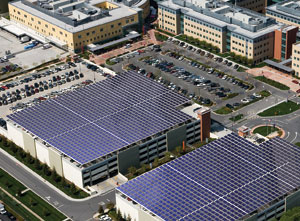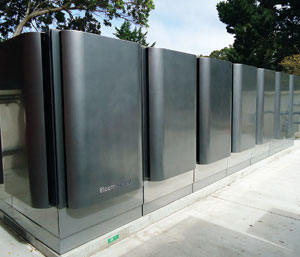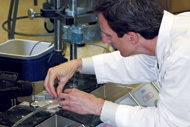As institutions dedicated to providing care and protecting public health, it is natural for many hospitals and health care systems to embrace energy-efficiency and alternative energy as complements to their core mission. Moreover, declining up-front costs, new financing models, and ever-improving technologies have put alternative energy within reach for an increasing number of health care organizations.
In addition to financial payback, these projects can have other benefits as well. They provide an excellent opportunity to engage staff, visitors and the local community. Also, by reducing dependence on the electrical grid or other fossil fuels, a hospital reduces its exposure to volatile energy commodity prices. Lastly, integrating renewable technologies offers a valuable educational opportunity for facilities professionals to stay current on the latest energy breakthroughs.
Mix of technologies
The optimal mix of technology type and financing structure varies dramatically from site to site. To optimize the effect of any energy technology, the planning process should take a holistic look at the building's energy profile, work to optimize its energy performance through efficiency, assess the viability of renewable energy solutions and seek creative ways to finance renewable projects.
Alternative technologies that have been used successfully in the health care setting include the following:
 |
|---|
| Photo courtesy of Recurrent Energy Photovoltaic systems mounted on structures can convert solar radiation into electricity. |
Solar systems
Solar photovoltaic (PV) systems convert incident solar radiation into electricity. Solar PV panels can be roof- or ground-mounted, integrated into a roof structure, shading or other facade features.
PV enjoys many federal, state and local subsidies, including a
30 percent investment tax credit for for-profit entities. For nonprofit organizations or organizations that do not wish to make the up-front capital investment in a solar system, new financing options are available that reduce investment by the hospital. These include solar leases, third-party ownership arrangements, local Property Assessed Clean Energy financing programs and solar power purchase agreements.
An additional benefit of PV is that it can be peak-coincident, lowering consumption during times of highest energy use. And, of course, solar panels are a highly visible way to show staff, patients and the general public a commitment to renewable energy.
One national health care system recently explored an enterprisewide approach to solar PV deployment, for example. The resulting solar program includes nearly 15 megawatts (MW) of PV across multiple sites.
Supported by the system's internal finance department, an engineering firm acted as program manager, conducting site assessments, competing feasibility studies, obtaining necessary permits and approvals, selecting a PV vendor and securing project financing. On average, the PV systems provide 10 percent of the power used at the sites that host them, making a meaningful dent in enterprise energy consumption.
The success of a solar project is location-dependent. An assessment of the amount of solar energy available at a site, as measured by direct normal irradiance, can determine roughly how much energy the system will produce. An understanding of local electric utility policies will determine how solar power can be used to offset electric bills. Both are critical during project planning.
Because a solar system only produces when the sun is shining, PV cannot provide base load power unless it's paired with an energy storage solution. As a result, solar cannot reliably be used for backup power. Another thing to keep in mind is that even with new financing solutions, PV is one of the more expensive technologies on a per-kilowatt basis. Additional costs like reinforcing the roof or installing new electrical service can add to project cost.
To ensure a successful PV project, hospitals should commission a feasibility study from an experienced firm that can evaluate site-specific conditions and make a recommendation on whether solar is feasible.
Similar to solar PV projects, solar thermal collector systems capture radiation in the form of heat, which can be used for space or process heating, fed to an absorption chiller to provide cooling, or used to produce domestic hot water or hot water preheat.
While visually similar to their PV cousins, solar thermal systems have a much lower up-front cost and can be deployed in less sunny areas. Because solar thermal systems typically do not generate electricity, they do not require interaction with the electric utility, making them easier to permit and install.
For instance, the dialysis division of DaVita HealthCare Partners Inc., Denver, installed solar thermal collectors on its dialysis clinic in Indiana. By adding solar thermal to its portfolio, DaVita reduced natural gas consumption by almost 40 percent, yielding significant savings and proving the viability of solar thermal in a health care setting.
As with PV, a detailed site evaluation is required and federal, state and local incentives are available to reduce up-front investment.
Wind systems
Wind is well-understood, reliable and cost-competitive with conventional power in many locations. Wind also enjoys federal, state and local incentives to mitigate up-front costs.
The size, design and styling of wind turbines have changed dramatically over the years. Large-scale, ground-mounted turbines and building-integrated wind technologies are most applicable to the health care setting. Both technologies convert wind energy into electricity, which can be used to reduce the purchase of conventional fossil fuel power.
Building-integrated wind turbines utilize natural wind patterns created by the built environment to turn turbines and create power. To maximize efficiency of these turbines, it's essential to understand the interaction among wind, the building and neighboring structures. A computational fluid dynamics model may be required.
Ground-mounted turbines are more established and should be sited where the wind resource is best. These are generally more efficient than building-integrated wind. As utility-scale wind farms begin to upgrade their ground-mounted turbines, a market for refurbished turbines has evolved, allowing health care facilities to procure turbines with many remaining years of useful life for deep discounts.
A multifacility health care system recently committed to install and operate an on-site, 1.6-MW ground-mounted wind turbine at its southern California facility. Working closely with zoning authorities, the facility gained special approval to install the turbine on-site. When complete, the system will fully offset the facility's energy use.
Supportive utility policies, specifically the ability to net meter excess energy produced by the turbine for use during times of underproduction, were critical to the success of the wind project. A lower-than-average up-front cost by using a refurbished turbine from a wind farm, also helped to boost the project's viability.
Production from a wind system is intermittent and depends on specific local wind conditions. Wind, unless coupled with storage, cannot be used to provide base load or backup power. Also, in most parts of the country, wind is not peak-coincident, meaning that a system will produce the most at times of lower on-site consumption.
Both ground- or building-mounted wind systems can trigger local building code restrictions, requiring special applications or exceptions. Above all, any wind installation must attend to wildlife concerns, flicker effects and potential noise impacts of the equipment.
If owning and operating a wind turbine on-site is not a good fit, a range of off-site options is available. One is to take an ownership stake in wind turbines located in a windier area and use the power produced to offset power used on-site. This requires specialized contracting expertise, but many renewable service providers can help. Another possibility is to purchase power directly from a utility-scale wind farm, if such an option is available locally.
Waste to energy
Waste to energy is a broad class of technologies, categorized by using a waste to create useful energy. Waste types that can be utilized include municipal solid waste, biogas created from landfills or wastewater treatment plants, agricultural waste and others. One example of the wide variety of available waste-to-energy projects is landfill gas (LFG).
LFG projects use the methane created by anaerobically decaying organic matter in municipal landfills. Unused, this LFG would escape into the atmosphere or be captured and burned, or flared off, to convert it to carbon dioxide and water.
When a landfill is located close to a large user of natural gas, there is opportunity to capture and use the LFG to replace natural gas that otherwise would be purchased from a gas utility. This involves connecting the landfill to the end user via a new pipeline. The pipeline is the major capital cost for these projects, so the closer the facility is to a landfill, the better.
If a health care facility is not located close to a landfill, the organization still can pursue a LFG project. Some facilities successfully have collected LFG off-site, cleaned it to local natural gas distribution utility standards, and put that landfill gas onto the natural gas utility pipeline network. While the facility will not burn the LFG directly, the net effect of reducing natural gas consumption is the same.
The effect of this relationship is akin to the renewable electricity credit system, where one site claims a renewable energy credit for renewable energy produced at a different location. In this case, the health care organization will need to work with the gas utility to pay the applicable transmission fees and ensure that the LFG is conditioned to pipeline standards.
Sentara RMH Medical Center (formerly Rockingham Memorial Hospital) in Harrisonburg, Va., has used LFG since 2010 to provide heat and hot water to its main hospital. Rockingham County's landfill previously flared 100 percent of LFG, wasting the energy without doing useful work. The facility and its team developed a system that conditions the LFG to remove impurities and pipes it 2.5 miles to the medical center site. The county owns the pipeline and the processing equipment; the medical center uses its existing boilers to burn the LFG.
In the winter, the facility meets nearly 100 percent of its heat demand using LFG, reducing its natural gas bill to zero. Currently, the facility saves about $250,000 per year. Since 2010, the medical center has been accessing federal funding to retrofit additional boilers and expand its use of LFG.
The largest challenge of LFG projects is the up-front cost of creating a new pipeline to connect the facility to the source of landfill gas, or installing equipment to purify the gas up to utility standards.
Using LFG to displace natural gas often requires little or no modifications to existing equipment. Facilities frequently can get good deals on the source landfill gas, because otherwise it would be wasted or flared at the landfill. LFG projects also are a good opportunity to partner with the local community to make positive use of an otherwise wasted and odorous byproduct.
Finally, an LFG project is one of the most direct ways to reduce greenhouse gas emissions.
 |
|---|
| Photo courtesy of Bloom Energy A fuel cell is an electrochemical energy conversion device that creates electricity. |
Fuel cells
A fuel cell is an electrochemical energy conversion device that converts hydrogen and oxygen into water, creating electricity in the process. Solid oxide fuel cells produce electricity only, while other types of fuel cells produce waste heat that must be utilized to achieve maximum efficiency.
Fuel cells offer several benefits. They are compact, quiet, produce high-quality power and may be able to serve as backup power after codes are clarified. However, unless a fuel cell uses a renewable source of power to create the hydrogen that they use — such as biogas — it is more of an energy-efficient technology than a renewable technology.
St. Helena (Calif.) Hospital installed a 400-kW fuel cell in 2010 to supplement the facility's power and heating demand. The equipment provides more than 60 percent of the hospital's electricity needs, reducing demand on the local power grid and improving system reliability. The fuel cell's byproduct thermal energy is used to meet the hospital's hot water and space heating demands. The system was funded in part by a utility grant program and in part by an anonymous donor. The system saves more than $100,000 in utility costs each year which, combined with utility incentives, created an attractive payback.
Many fuel cells use natural gas to create the hydrogen needed to operate. While this is sometimes a more efficient way to create electricity, it is still dependent on a fossil fuel. Also, in some parts of the country with adequate renewables, hydro and other carbon-free sources on their local electrical grid, the greenhouse gas benefits of a fuel cell can be minimal.
Fuel cells are a promising technology and enjoy federal, state and local subsidies to bring down their up-front cost. However, because their greenhouse gas and energy-efficiency benefit depends on several local factors, a detailed feasibility study is critical to determine if a fuel cell is appropriate for a facility.
Great potential
As part of a balanced energy management strategy, alternative energy has great potential in the health care industry.
When considering these technologies, facilities professionals should build an experienced team that includes engineering, policy and permitting, financing and project implementation representatives.
A project will stand the best chance of long-term success with the right team, patience and a firm understanding of local conditions.
Emily Fadrhonc, LEED GA, is energy program manager and Arash Guity, PE, LEED AP, CEM, is chief sustainability engineer for Mazzetti in San Francisco; and Amy Jarvis, PE, LEED AP, is associate sustainability engineer for Mazzetti in Portland, Ore. They can be reached at efadrhonc@mazzetti.com, arashg@mazzetti.com and amyj@mazzetti.com, respectively.
Other technologies for hospitals to consider
Renewable energy technologies are those that directly convert a natural source of energy — sun, wind, water and biogas — into useful thermal or electrical power. Some technologies often are grouped together with renewables, but are better thought of as energy-efficient technologies.
Ground-source heat pumps, an energy-efficient technology, use the earth and its groundwater as a heat source and sink for conventional heat pump systems. They are an alternative to conventional air-source heat pumps, although they are often confused with geothermal energy. Geothermal energy is relatively rare and limited to certain geologically active parts of the world, as it requires direct use of hot water or steam from deep in the earth to create heat or electricity.
Cogeneration — the simultaneous generation of useful electricity and heat — also should be viewed as energy-efficient technology. Microturbines, backpressure turbines, heat-recovery steam generators and other technologies fall into this category.
Energy storage, an important and emerging field, can store energy from the grid or from a renewable energy system for deployment during peak or high-cost times. These systems can improve the impact of a renewable system or simply can help to balance the daily load. While storage is critical to dealing with the intermittency of many renewable technologies, it is not inherently a renewable solution.
Both cogeneration and ground-source heat pumps are incentivized by federal, state and local programs and deserve consideration as part of an energy portfolio.





